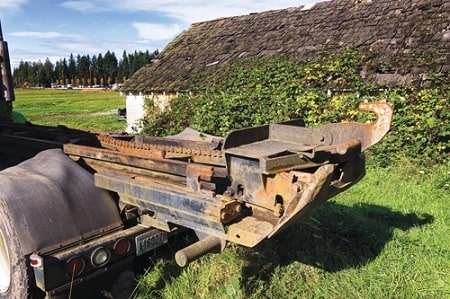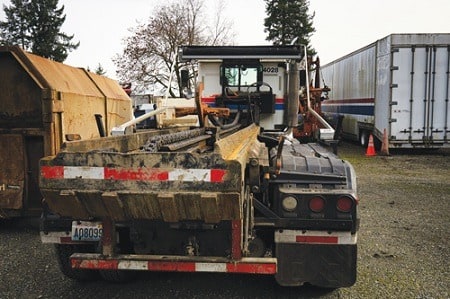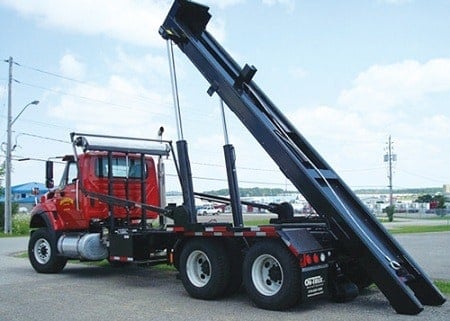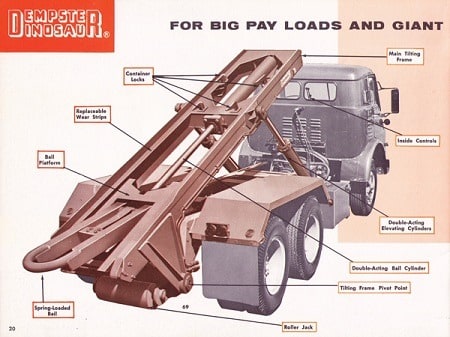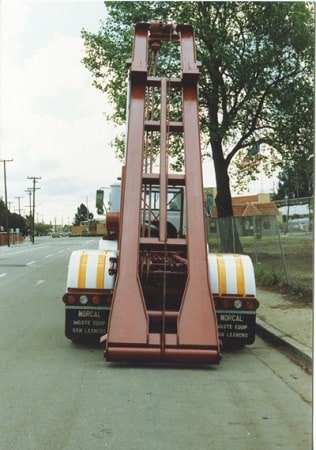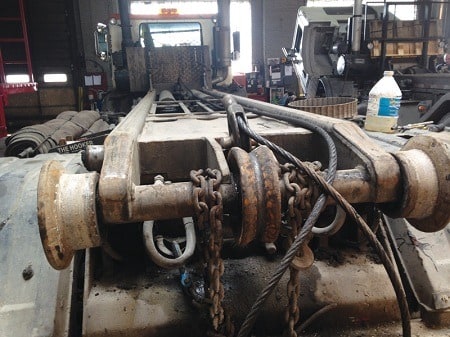Discussing the history and different styles of roll-off trucks used across America.
By Zachary Geroux
When I got it in my head late last year to write about the different types of roll-off hoists and their history, I had no idea what I had gotten myself into. Roll-off trucks are the most commonly operated vehicle in the waste industry and are often found used in many applications not associated with refuse collection. It’s the easiest way for a new company to break into the market around the country and have any chance of success due to franchise laws usually not applying to drop boxes use. I’ll say this right now, the history I have today is fragmented and pieced together, partially conjecture and in no way complete. What I did find surprising was that when it comes to buying new or used roll-off hoists, everything is driven by the boxes and the types of skids underneath. It makes sense that when you look at the investment, each box is compared to roll cars or front load dumpsters which are standardized and nationally universal. If you’re reading this and see something in error or have anything to add, please contact and enlighten me.
Let’s Try and Start At A Beginning
We can’t discuss this history of roll-off trucks without starting in the 1930s with George Dempster and the Dempster Dumpster lifts. Originally, it was conceived for his family’s construction site as a way to move material around in open top buckets. Now keep in mind, the 1930s saw a national move towards enclosed refuse collection bodies as technology started to improve. Heil, Gar Wood, Leach and Roto Pac had bodies that were starting to be used by many city municipalities and private haulers. However, the storage prior to pick up was severely lacking as people were starting to realize what a health hazard it portrayed in densely populated areas such as apartments and businesses. Most residential areas still allowed the burning of trash in barrels in one’s backyard and the consumerism of the 1950s on was not as prevalent in that society, so the average citizen did not produce as much waste.
George’s hometown of Knoxville, TN was the first to adopt the Dempster Dumpster in 1937 becoming known as “Dumpster City” with the purchase of a single truck and 18 2-yard containers. The city found that it cut costs in half compared to the old method of open top trucks and virtually eliminated insects and vermin by enclosing the trash and keeping it from the elements. Disposal sites were relatively close or near city limits and one man could now do the work it would take two or three before.
This revolution in the waste industry did not take hold immediately but there were more and more cities that became “Dumpster Cities” as the decade progressed. By the 1940s, Dempster was exclusively making equipment for the waste industry and the word “Dumpster” became synonymous with any enclosed container used to contain refuse.
Now if you’ve read any of my articles before you’ll know that post-WWII America was the driving force behind almost every revolution within the waste industry. The economic boom of the 1950s saw people moving out of the densely populated cities into suburbs, the rise of consumerism and supermarkets. I believe it was these factors that gave rise to the roll-off truck. I have no idea who or where the roll-off truck concept was first invented; in all of my research and interviews, I’ve not met a person who does. However, I can postulate that it was an evolution of the Dempster Dumpster concept as the need rose for larger containers to hold material at businesses and construction job sites.
More than likely it was a private operator in the very early 1950s who came up with the concept and had a local or in house fabrication shop create the hoist and boxes as a way to get an edge on competition. As with most inventions of this sort, that deal with the logical evolution of an existing product, it more than likely happened simultaneously on the East and West coasts. I would also like to add that the scrap metal industry is a major player when it comes to the evolution of roll-off trucks; I would not be surprised if they were the original inventors of the roll-off concept and it was hijacked by the waste industry shortly after. By the mid to late 1950s we see roll-offs used and advertised nationwide and as often found in the early adoption of a new piece of collection equipment, each had their own standards and unique quirk in either the boxes or rails so as to keep their customer base loyal and prevent rival hauler theft. And with this, we get into the meat of the article.
Let’s Talk Rails
For the purposes of this article, I will not be discussing or including hook lift or Lugger trucks. Depending on where you live in the country, you might not realize that there are eight different types of rails used with the traditional roll-off truck. For those who find this surprising, let me list them off for you: Outside Rail, SoCal Outside Rail, Inside Rail, Dempster Dinosaur, Dead-lift, Brantford, Continuous Chain and NorCal C-Channel. Each has their inherent strengths and weaknesses so let’s discuss each one.
Outside Rail (OR)
The most common style in the country, the outside rail features a rail width of 35 ½ inches with rollers placed along the side of the frame for the box skids to ride along. Defined by the rollers used on the outside of the frame and where the skids fit in relation with the rails, this was one of the earliest and most popular styles, which came to dominate the Eastern and Midwest market. It was not until the ANZI standards came along in the early 1970s when 35 ½ inches defined the OR dimensions with many smaller companies making wider or narrower widths in various pockets around the country. This is the standard style of hoist offered by almost every roll-off manufacturer in America, with the major differences you find being the height of the rails.
SoCal Outside Rail (SCOR)
As I said previously, the roll-off concept seemed to have happened simultaneously on each coast and the SoCal Outside Rail is a perfect example of this. With all of the same features as the standard OR hoists, the key difference is the width of 34 ½ inches on the rails. Started by the S. Vincent Bowles Company who made the first roll-off trucks in Southern California, 34 ½ became the standard width still used by every company in that area today. Stories have been related to me of owners buying trucks from outside Southern California, not realizing the width difference and trying to use them with their boxes. The grinding sound I’m sure was intense!
Inside Rail (IR)
To the average hauler east of the Rockies, when you say Inside Rail, they would think of the Dempster Dinosaur style boxes. However, there were Inside Rail trucks from what I can piece together since the advent of roll-offs. Defined as one would imagine by the skids under the box riding inside the rails either on bare metal or rollers, their width varied from each manufacturer to the next. Today, anything narrower than 34 inches is usually referred to as IR; however, you would be hard pressed to find a box still in use outside of the Dinosaur style. They were phased out years ago due to their easy tendency to jump rails during transit or loading because of the narrow skids and I’ve found no literature past the 1960s that offered dedicated IR hoists.
Dempster Dinosaur
The brainchild of William A. Herpich (you may remember the name from the February and March E-Z Pack articles), Dempster broke into the roll-off market swinging in 1958. Dempster had spent the earlier part of the decade making a name for themselves with the Dempster Dumpster and Dumpmaster Front Loader. They had built up quite a dealer market and were the largest manufacturer for commercial refuse equipment. At this time Heil, Gar Wood and Leach were the only companies making bodies primarily for the residential markets so Dempster was left mostly uncontested. Never one to follow the status quo and copy what other companies were building, Dempster introduced a completely new way to load and unload boxes via a spring-loaded bale and hydraulic cylinder. At this time, most every roll-off being built was using a cable and winch to drag the boxes onto the rails. This required the driver to get out of the cab to hook and un-hook the box. With Dempster’s system, the driver could remain inside the cab during the loading and unloading process, saving time and money.
The Dinosaur boxes featured teeth underneath the box in between the rails, which the bail would engage as the container was dragged up through successive cycles of the double acting cylinder. The hoist was much shorter than the comparable cable hoist as the box was dragged forward of the hoist. Another advantage of the Dinosaur compared to the cable hoist was that it didn’t rely on gravity for unloading as the cylinder could push the box off the rails while the hoist was horizontal, allowing for easy transfer to a loading dock or trailer. The skids under the box were 34 inches wide and ran on the inside of the rails.
Many haulers adopted the Dinosaur system due to the advantages it offered compared to a cable system. When national companies started acquiring smaller haulers and the consolidation across the industry happened, roll-off manufacturers started building Inside/Outside Rail cable hoists so a hauler could use one hoist for different box types due to acquisition or merger. Dinosaur boxes came to be referred to as Inside Rail due to their prevalence. You can still find some companies who are still loyal to the Dinosaur system and roll-off manufacturers who still make the hoists even though the last iteration of Dempster folded in the early 2000s.
Dead-lift (DD)
Again, one of the original styles of roll-off hoists, they were made popular with the Heil “Huge Haul” due to Heil’s dealer network. Using a standard cable system, the rails stopped at the back of the truck frame and the box was physically pulled up onto the rails instead of the traditional method of lifting the rails on other hoists, which had longer rails in order to line up to the skids at the front of the container. Great in areas where height clearance is an issue, because the rails do not need to be raised very high during loading, they are almost exclusively run in Chicago today. Once Heil discontinued the Huge Haul and other companies started making the rails to support the market, they were referred to as “Dead Lifts.” The containers feature skids that run up the front of the box which connect to rollers at the back of the hoist to help guide the container as it is being lifted to ensure proper placement on the rails. Today, the standard skid width is 36 inches on most deadlift containers and the rails feature rollers along the frame just like an Outside Rail frame.
Brantford Rail
Used almost exclusively in Canada and named for the town in Brantford, ON where I assume it was first created, these hoists have no rollers and the boxes ride directly on top of the rails. Called “elegantly beautiful” by a few notable people I’ve talked to who make roll-offs in the U.S., this hoist truly shows that the need for rollers along the frame seems archaic today. Many built by Canadian companies feature a 6″ to 8″ (some are 10″) tall rail with replaceable wear strips on the top of the hoist. The widths vary from 34″ to 36″ depending on the region and can also be customized as Inside/Outside rails.
Continuous Chain
Used exclusively in the Pacific Northwest, this system has many of the same features as the Dinosaur. Invented and built in Portland, OR during the mid-1950s by the Kuhnau family, it uses a chain operated by a gear drive with a bail hook on the end. Early models had the bail hook ride on a carriage frame on top of the rails to which the chain was attached on each end. Today, the carriage has been eliminated in favor of an I-beam running along the center of the hoist to which to bail hook rides on.
With container skids 34″ wide, the box rides on top of the rails and is secured by spring loaded hooks located at the back of the rails on each side, which engage brackets welded underneath the container. This opposing force on the container prevents it from moving or sliding during transport and, in my opinion, is the safest way to secure the container out of all the different hoists.
Similar to the Dinosaur, this hoist allows the driver to remain in the cab during loading and unloading of the container and doesn’t require the use of gravity to move the box, making it easy for trailer loading. With the bale located on the front of the box, which the hook engages, many manufacturers offer a second hook hydraulically actuated connected to the front bumper to allow easy placement of empty containers in tight spots. Harold Alexander, who held a patent on the Continuous Chain, licensed the design to Gar Wood in the late 1960s, who marketed it nationwide as the Gar Wood Dispos-Hall Roll-off. It was a short-lived venture and it is unknown if any units were sold.
Northern California C-Channel
Built exclusively by NorCal Waste Equipment in San Leandro, CA, these unique hoists feature a 4″ to 6″ wide rail. It was designed to handle a multitude of different skid widths, which was prevalent in the San Francisco market in the late 1960s/early 1970s because of rival hauler box theft. The style is similar to the Brantford and Chain style hoists in that they don’t use rollers and the boxes sit on the top of the rails.
Loading Methods
I touched on the different methods that hoists load and unload the boxes onto the rails, but I wanted to briefly elaborate on several of them in this section. Aside from the Dempster and Chain systems, cable is universal across America. Early on a winch was used mounted mid-way along the rails up to the 1970s when the industry started moving to the better reeving cylinder system which provided more pulling capacity.
In my research, I tried to nail down when and who invented the reeving cylinder set up, but I got conflicting answers, so I’ll leave it a question mark for now. What I do know is that the reeving system was used as early as the 1960s with the Heil Huge Haul and many companies offered both winch and reeving systems until the industry standard became the reeving.
Several companies have modified the use of the reeving system to allow movement of the container when the rails are horizontal without the use of gravity. You find this most prevalent with Canadian companies who make the Brantford rails and as an added benefit it shortens the length of cable needed.
Wrapping Up
As I stated in the beginning of the article, I don’t have all of the answers or history and need you the reader to help enlighten me so I can publish an update to this article at a later date. If you have any pictures of roll-off trucks you owned or operated in the past, I’d love to see and share them.
I hope to see you at Waste Expo this year, please don’t hesitate to come talk to me; I’d love to hear your story and talk about history. I’ll be there the entire show and would love to hear your feedback on the articles I’ve written or ideas for future ones. | WA
Zachary Geroux is a historian, photographer, videographer, and owner of Refuse Truck Photography. He lives in Western Washington with his wife where he currently works full time for the Air Force, is focused on growing his business and has been driving garbage trucks off and on for the past ten years. He can be reached at (541) 301-1507, e-mail [email protected] or visit www.refusetruckphotography.com.
Any company that I mention or hoist I specifically discuss is not meant as free advertisement or endorsed by the magazine. This is wholly independent, historical and educational article.
